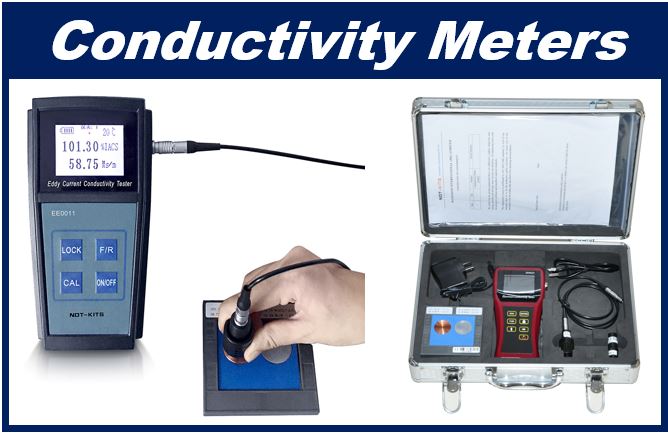How do you test the health of a water body, soil, or metal? You measure its conductivity. This is the ability of a substance to conduct or pass electricity or an electric current. To pass a current, a solution must have charged particles or ions from electrolytes dissolved in it. If the test solution contains a high concentration of ions, then the conductance is high.

That said, there are three factors that affect conductivity; type of ions, the concentration of ions, and the solution’s temperature.
Conductivity is measured in the laboratory or in field applications using a conductivity meter. These meters are used heavily in agriculture and water treatment facilities to measure the salinity levels of soil samples and surface water. It can also test the integrity of metal.
So, what is a conductivity meter, and how does it work?
A conductivity meter is a handheld device equipped with a probe to measure the amount of electrical current in a liquid solution. It is also used to measure changes in wastewater processes in water treatment plants.
The meter shows conductance as the inverse of a resistivity measurement in ohms/com, which means conductivity is measured in mhos/cm. To ensure a conductivity probe measures the exact conductance of a solution, the meter must be calibrated.
What is the Conductivity Meter’s Basic Principle?
To understand the basic principle, it’s essential to know about the two types of a conductivity meter;
1. Contacting-type conductivity meter
This type of meter has a probe with two metal electrode plates- cathode and anode set 1 cm apart that comes in contact with the solution. The meter applies an alternating voltage to the plates, and the electric field in the solution causes the ions to move back and fro, causing a current between the two electrodes.
When conductance is high, you will note a fast current flow, and conversely, while the electrical current is slower and gives a smaller reading, it means conductance is low. However, some contacting-type meters have four electrodes where it injects an alternating current through the outer electrodes and measures the voltage from the inner electrodes.
2. Inductive conductivity meter
Also known as toroidal or electrodeless conductivity meter, this inductive sensor consists of two wire-wound toroids encased in a corrosion-resistant plastic body. One toroid is a drive coil, and the other a receive coil.
When the meter is immersed in the solution, it applies an alternating voltage to the drive coil, which induces a voltage in the solution. The voltage causes an ionic current to move proportional to the conductance of the solution.
Another principle that you must consider when using a conductivity meter is the temperature of the solution. Conductivity is highly temperature-dependent, so you must use a temperature compensated instrument. Calibrate the instrument to be the same temperature as the solution you are testing.
How to Measure Conductivity for Metal
The electrical conductivity of a metal is simply a measure of how easily electrons flow through the metal. While all metals are generally good conductors of electricity, their conductivity differs depending on the atoms in the material and the structure.
There are two basic methods to measure the conductivity of metal;
1. Traditional electric bridge method
You have to pull a wire from metal and use a digital multimeter to quantify the resistance of the wire from one end to the other. You have to attach both sides of the wire to the leads in the multimeter while it’s in resistance measuring mode. The conductivity will be 1/ (resistance x length of the wire).
2. Eddy current method
This is a non-destructive testing method that uses a portable metal conductivity meter to determine the electrical conductivity of different metals. The technique is simple, more accurate, and abides by the national standards. A good metal conductivity meter will come with automatic temperature compensation and a simple calibration process to ensure accuracy.
Interesting related article: “Superconductivity with graphene is possible.”

